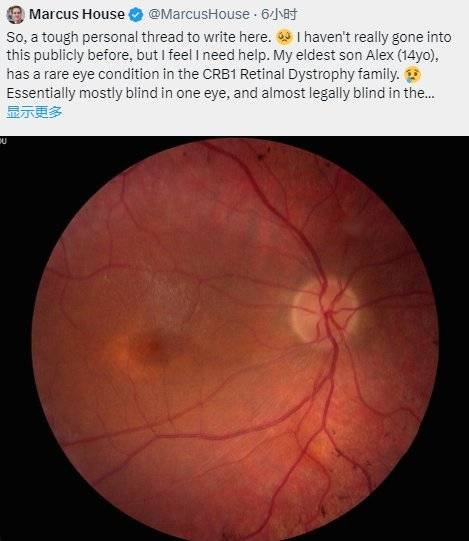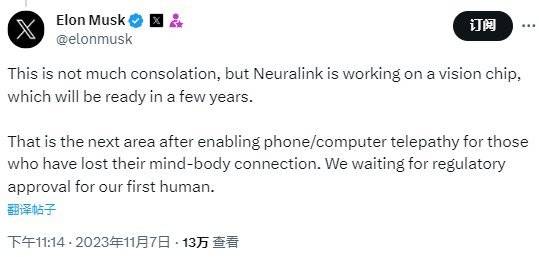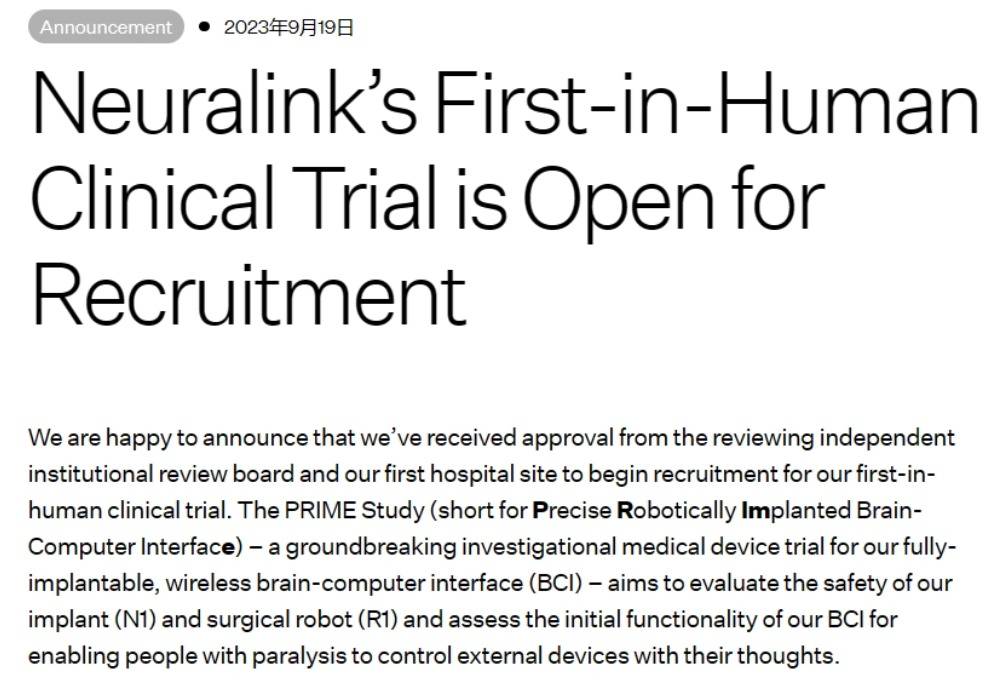 Technology peripherals
Technology peripherals
 AI
AI
 Musk reveals big news! Its brain-computer interface company is developing a vision chip...
Musk reveals big news! Its brain-computer interface company is developing a vision chip...
Musk reveals big news! Its brain-computer interface company is developing a vision chip...
Edited by: Du Yu
Musk has made another major move? This time we are working hard for the visually impaired community
Marcus House, a well-known Australian technology media person, pointed out in a social media post on Tuesday that his 14-year-old son Alex suffers from CRB1 retinal dystrophy, a rare eye disease
Alex’s current condition is that he is almost completely blind in one eye, and the other eye has also reached the legal standard of blindness. House said that because the disease is rare, it is difficult for him to find other parents in similar situations, so he hopes to find families who have experienced the same situation online, or professionals who research this field.

(Image source: X social media platform)
Subsequently, Musk responded to this post. Musk said: "Neuralink is developing a vision chip, which is expected to be completed in a few years. After helping those who have lost the connection between the body and the brain to achieve mobile phone/computer telepathy, this is our The next area of research. We are awaiting regulatory approval for our first human subject.”
 (Source:X)
(Source:X)
The Neuralink mentioned by Musk is a brain science company he founded in 2016 with a number of scientists. As the name suggests, the company's main research direction is brain-computer interface - realizing "interaction between human brain and machine" by developing a device that can be implanted in the brain.
Musk’s brain-computer interface startup Neuralink announced on September 19, 2023 that the company had received approval from an independent review committee and
will conduct the first human trialof implanting devices in the brains of paralyzed patients. . According to Neuralink,
This human trial will last for six years. Participants will first participate in an 18-month study, after which they will spend at least two hours a week doing brain training. Research on computer interfaces.
 Image source: Neuralin official website
Image source: Neuralin official website
According to China Securities Journal,
On May 26, Beijing time, Neuralink, a brain-computer interface company owned by Musk, officially announced that its first human clinical trial was approved by the U.S. Food and Drug Administration (FDA).According to Musk, Neuralink is designing a device that converts brain signals into actions. It will first focus on two applications: one is to restore human vision, and the other is to help people who cannot move muscles control devices such as smartphones. Even restore the whole body functions of people with spinal cord injuries. The so-called "brain-computer interface" is to implant tiny electrodes in the brain and use electric current to allow the computer and brain cells to interact. Musk released his first product in 2019. The principle is to use a laser to drill holes in the skull, then avoid the cerebral blood vessels and implant a line into the brain. In August 2020, in order to verify the effect of the brain-computer interface, researchers implanted devices in three pigs. Musk showed the audience the real-time transmission of the piglets' brain activities during a live broadcast.
Before the successful application for human clinical trials, it is worth mentioning that Neuralink has already conducted relevant trials on pigs and monkeys and caused a sensation
In April 2021, Neuralink released a video showing a monkey implanted with its device playing a video game telepathically to demonstrate the research team's major breakthrough in brain control research.
 Picture source: CCTV Finance
Picture source: CCTV Finance
According to CCTV Finance, a macaque named Pug demonstrated the application of brain-computer interface in a video. Before the video was shot, the research team implanted a brain-computer interface into Pug's brain. Initially, the team taught Pug to play with a joystick and rewarded him with banana milkshakes through a metal straw. During this process, the brain-computer device recorded Pug's neuron activity and established a neural activity model related to the expected direction of movement, thereby realizing a "brain-computer connection"
Although,
Brain-computer interface companyNeuralin only began human trials a few months ago, implanting devices into the brains of paralyzed patients. If the "brain-computer interface" can help people who have lost their sight regain their sight, it will be an important breakthrough recorded in the history of human civilization. According to the National Eye Institute, serious vision-related illnesses continue to grow. Currently, there are about 1.3 million blind people and 2.9 million people with low vision in the United States. It is estimated that these two numbers may increase to 2.2 million and 5 million by 2030
Daily Economic News is the content that needs to be rewritten, integrating China Securities Journal, CCTV Finance, Neuralin official website, and public information
Daily economic news is what needs to be rewritten
The above is the detailed content of Musk reveals big news! Its brain-computer interface company is developing a vision chip.... For more information, please follow other related articles on the PHP Chinese website!

Hot AI Tools

Undresser.AI Undress
AI-powered app for creating realistic nude photos

AI Clothes Remover
Online AI tool for removing clothes from photos.

Undress AI Tool
Undress images for free

Clothoff.io
AI clothes remover

AI Hentai Generator
Generate AI Hentai for free.

Hot Article

Hot Tools

Notepad++7.3.1
Easy-to-use and free code editor

SublimeText3 Chinese version
Chinese version, very easy to use

Zend Studio 13.0.1
Powerful PHP integrated development environment

Dreamweaver CS6
Visual web development tools

SublimeText3 Mac version
God-level code editing software (SublimeText3)

Hot Topics
 1378
1378
 52
52
 Top issue published! Professor Li Yibin's team from Shandong University developed a simple and highly maneuverable wheel-legged composite robot
Jun 08, 2023 am 10:15 AM
Top issue published! Professor Li Yibin's team from Shandong University developed a simple and highly maneuverable wheel-legged composite robot
Jun 08, 2023 am 10:15 AM
Humans have dreamed of developing mobile mechanisms that can adapt to a variety of wild terrains since ancient times. Wheeled mobile platforms have better motion stability and mobility efficiency, but are difficult to travel in rugged terrain; legged robots have better terrain adaptability and mobility flexibility, but their motion stability and energy efficiency need to be improved. In order to combine the advantages of wheeled movement and leg-foot movement, the wheel-leg composite movement mechanism was developed. Common wheel and leg composite mechanisms mainly include special-shaped wheels (such as RHex), spoked wheels (such as Whegs), deformed wheels (such as OmniWheg), wheel legs in series (such as Wheeled-ANYmal), etc., as shown in Figure X. Figure 1 Common wheel-legged composite robots Recently, the team of Professor Li Yibin of Shandong University and Ma Shu of Ritsumeikan University in Japan
 Apple R&D (Beijing) Co., Ltd. patent reveals revolutionary electronic device: rollable display appears
Jul 17, 2023 pm 01:13 PM
Apple R&D (Beijing) Co., Ltd. patent reveals revolutionary electronic device: rollable display appears
Jul 17, 2023 pm 01:13 PM
According to news on July 14, the latest patent released by Apple R&D (Beijing) Co., Ltd. shows that they are developing an electronic device with a rollable display. The patent describes an electronic device that features a rollable display and a transparent protective layer. The display has an array of pixels used to produce the image, and a transparent protective layer overlaps the pixel array. The monitor can be kept flat when unfolded or rolled up for storage. The transparent protective layer may include a glass layer that may be locally thinned in the rollable portion to facilitate roll-up of the display. Additionally, compressive stress in the outward-facing glass surface effectively prevents damage to the display when it bends during the curling operation. According to industrial and commercial information, Apple R&D (Beijing) Co., Ltd.
 Former Apple employees develop screen-less AI hardware products that support GPT-4
Oct 30, 2023 pm 05:45 PM
Former Apple employees develop screen-less AI hardware products that support GPT-4
Oct 30, 2023 pm 05:45 PM
[Global Network Technology Comprehensive Report] On October 30, according to foreign media, Humane, a smart software and consumer device developer co-founded by two resigned Apple employees, will release its first product that has been developed for several years on November 9. The first product, AiPin, is about the size of a biscuit. It is equipped with a camera, microphone and speaker, sensors and laser projector, but has no screen. It can be magnetically fixed on clothes and is a "clothing-based wearable device." According to Humane’s official website, AiPin does not need to be paired with a smartphone or other auxiliary device. It is a screen-free independent device and software platform, and supports device functions through a combination of proprietary software and OpenAI’s GPT-4. In addition, its AI-driven optical
 Brain-computer interface shines into reality! The Ministry of Industry and Information Technology will focus on cultivating it in the future. How far is the road to industrialization?
Jun 02, 2023 pm 11:34 PM
Brain-computer interface shines into reality! The Ministry of Industry and Information Technology will focus on cultivating it in the future. How far is the road to industrialization?
Jun 02, 2023 pm 11:34 PM
Brain-computer interface shines into reality! The Ministry of Industry and Information Technology will focus on cultivating it in the future. How far is the road to industrialization? China Times (www.chinatimes.net.cn) reporter Qi Meng and Zhang Zhi Shenzhen report Essential elements in the film. Now, brain-computer interfaces have become a reality. On May 29, at the "Brain-Computer Interface Innovation and Development Forum", Zhao Zhiguo, chief engineer of the Ministry of Industry and Information Technology, introduced that with the joint efforts of the industry, my country has formed a full industry chain of brain-computer interface covering the basic layer, technical layer and application layer, and It has been applied in medical, education, industry, entertainment and other fields. He said that the Ministry of Industry and Information Technology will use brain-computer interfaces as a tool to cultivate future
 Popular in the investment circle! Is brain-computer interface a track that can be won?
Jun 03, 2023 am 10:14 AM
Popular in the investment circle! Is brain-computer interface a track that can be won?
Jun 03, 2023 am 10:14 AM
Author/Editor of Baked Buns Under the Starry Sky/Spinach’s Starry Sky Typesetting/Leeks Under the Starry Sky Brain-Computer Interface, a term with a science fiction flavor, has recently become one of the most common hot words among investors. After all, no sector can Like it, the index can rise 8.2% in a single day. Simply put, the brain-computer interface establishes a direct connection between the human brain and external devices, allowing our brains to have a "dialogue" with the machine. This pathway is to measure and collect the activities of the central nervous system, and then translate them into signals that can be recognized by the outside world. Recently, at the "Brain-Computer Interface Innovation and Development Forum" of the Zhongguancun Forum, a leader from the ministry also proposed that my country has formed a full industry chain of brain-computer interface covering the basic layer, technical layer and application layer, and it has been applied in medical,
 Musk, brain-computer interface, the first tool
Jun 04, 2023 am 09:49 AM
Musk, brain-computer interface, the first tool
Jun 04, 2023 am 09:49 AM
From "Silicon Valley Iron Man" to "Realistic Iron Man", Musk has become "Human Tony Stark", which is gradually becoming a reality. Just a few days ago, Musk's brain-computer interface company Neuralink announced major progress - it has received approval from the U.S. Food and Drug Administration (FDA) and will launch its first human clinical study, which means that their device will be implanted in the human brain. It is reported that they will focus on two applications: restoring human vision and helping people who cannot move muscles control devices such as smartphones. In November last year, Musk made a bold statement, saying that Neuralink was still about 6 months away from its first human trial. But later, due to high safety risks, violation of animal rights, and suspected illegal transportation of dangerous pathogens...
 Revealing the origin of Golang: Does Golang really originate from Google?
Feb 26, 2024 pm 10:54 PM
Revealing the origin of Golang: Does Golang really originate from Google?
Feb 26, 2024 pm 10:54 PM
Exploring the mystery of Golang: Is Golang really developed by Google? Golang, also known as Go, is an open source programming language developed by Google. It was designed in 2007 and officially released in 2009. Since its release, Golang has quickly risen to become one of the most popular programming languages among programmers. However, some people have doubts about the origin of Golang. Is Golang really developed by Google? Let's unravel this mystery together. First, let's take a look at
 The Brain-Computer Interface Industry Alliance successfully held an academic exchange seminar on 'Brain-Computer Interface + Depression'
Sep 20, 2023 pm 09:53 PM
The Brain-Computer Interface Industry Alliance successfully held an academic exchange seminar on 'Brain-Computer Interface + Depression'
Sep 20, 2023 pm 09:53 PM
In order to fully investigate technology development trends, explore the direction of industrial development, and discuss interdisciplinary cooperation models, on September 11, 2023, the Brain-Computer Interface Industry Alliance organized the second phase of "Bright Stars" with the theme of "Brain-Computer Interface + Depression" Event academic exchange seminar. This seminar aims to promote the connection between supply and demand and knowledge sharing, and further promote the development of the brain-computer interface industry. The seminar was hosted by Zhou Jie, Chairman of the Alliance System and Industry Application Group. This seminar attracted widespread attention from members of the Brain-Computer Interface Industry Alliance. Nearly 300 people attended the seminar, and the atmosphere of the online discussion was lively. At the seminar, Sun Bomin, co-director of the Brain-Computer Interface and Neuromodulation Center of Ruijin Hospital, spoke about "Brain-Computer Interface in Depression" Titled "Application in Neuromodulation of Depression", a detailed introduction to the treatment of depression in the brain was given through clinical examples.



